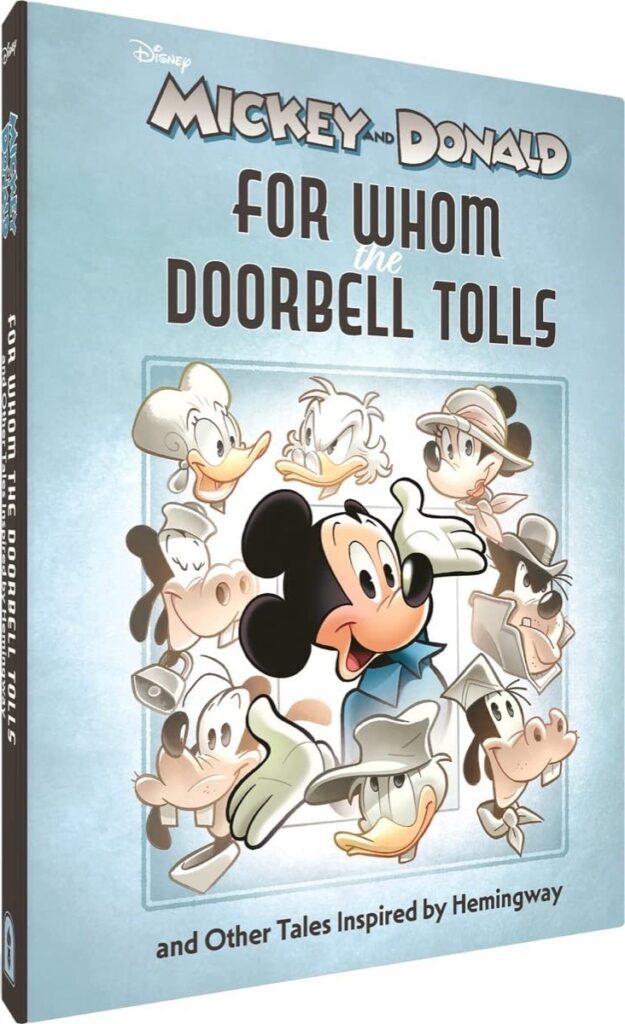
In 1999, a teacher at Disney’s Italian school for cartoonists presented his students with a prompt: select a short story by Ernest Hemingway as the inspiration for a new Disney comic. There were no guidelines for strict adaptation of any story, just the direction to use Hemingway’s work as a starting point, a concept, or a central character in the new comics. The results of that experiment are collected here for the first time in the U.S., along with a couple of other related comics.
If the thought of reading a nearly 25-year-old student project doesn’t sound particularly intriguing, rest assured that the quality is completely professional and on par with the work regularly featured in the ongoing weekly Italian Disney comic, Topolino. In fact, many of the students went on to contribute to the weekly comic, and one is the current art supervisor. Perusing the comics without preamble, most readers would never guess that they were anything other than “regular” Disney comics. Of course, Italy has outstripped the U.S. in Disney comic production for many decades now, with Topolino output serving as the basis for most U.S. Disney comic collections, so the work here is about as regular as it comes.
The teacher’s selection of Hemingway short stories as the starting point generates both familiarity and newness, because even if you know Hemingway’s novels and themes, most readers aren’t going to recall or be aware of his short stories. The artists exhibit amazing writing creativity with their choices, feeling free to venture well off the track of Hemingway’s stories but always generating entertaining Disney tales.
Fantagraphics has wisely included a primer preceding each comic, providing an overview of each original short story along with each artist’s recollection of their creative thought process. They also feature pictures of Hemingway throughout his life, from hunky young Red Cross volunteer during World War I through to the familiar old man.
While the students mostly hew closely to the House of Mouse art style, there is a bit of interesting visual variation. In Andrea Frecerro’s “Boiling Point”, Scrooge McDuck and Brigitta MacBridge have such exaggerated facial expressions that they surpass Topolino great Casty’s frenetic style. Alessandro Perino’s Mouseton-set “Bad Boys” eschews the standard flat coloring for a seemingly airbrushed style full of shading and gradation.
If you have no interest in Hemingway, the student comics diverge enough from his legacy that they can simply be enjoyed as fun Mickey and Donald yarns, no literary knowledge required. The only exceptions are the two bonus comics that close out the collection: “The Older Man and the Sea” and “For Whom the Doorbell Tolls”. The first is one in a long tradition of Disney parodies of literary works, while the latter features Hemingway himself as a character in a story specifically created to commemorate the centennial of his birth. At 30 and 20 pages, they’re also the longest entries in the book, the weighty desserts after all of the savory student appetizers.
The hardcover book is just slightly larger than the ongoing Carl Barks series from Fantagraphics, as well as past Timeless Tales collections from IDW. At 7.8” x 10.6”, it slots in perfectly with the ongoing Disney Masters series from Fantagraphics. Printed on matte, acid-free paper, the book is made for the discerning collector but also built tough enough for public library deployment.
If you’re approaching this book primarily as a Hemingway fan, you’re likely to be unimpressed by the frequently radical departures from his short stories. This collection is not a typical literary adaptation; it is instead an innovative lab experiment utilizing the author’s works as a jumping-off point for inspired creativity. Disney comic fans will be right at home here, even with no knowledge of the works of Hemingway.
Mickey and Donald: For Whom the Doorbell Tolls is available on March 21, 2023.